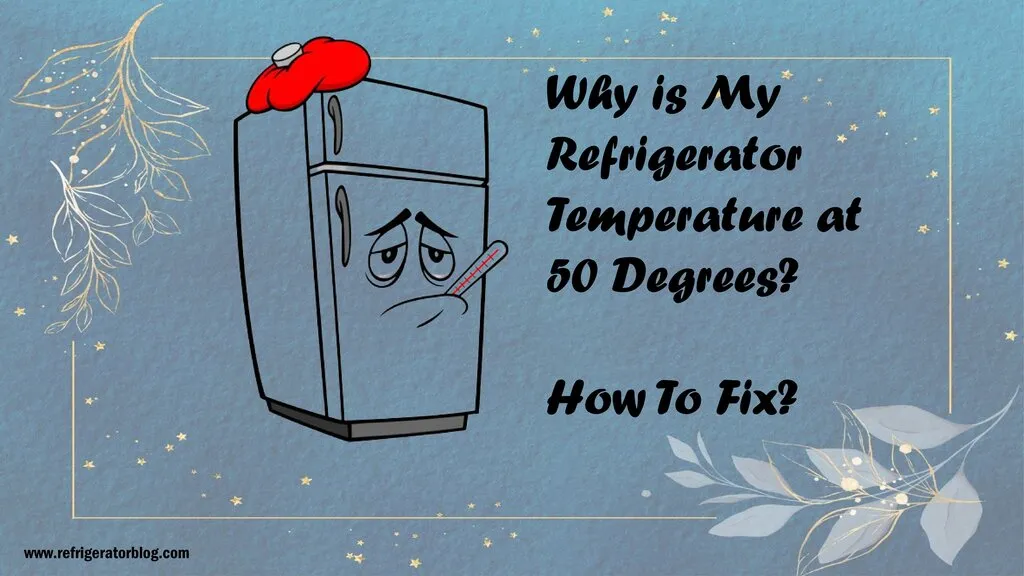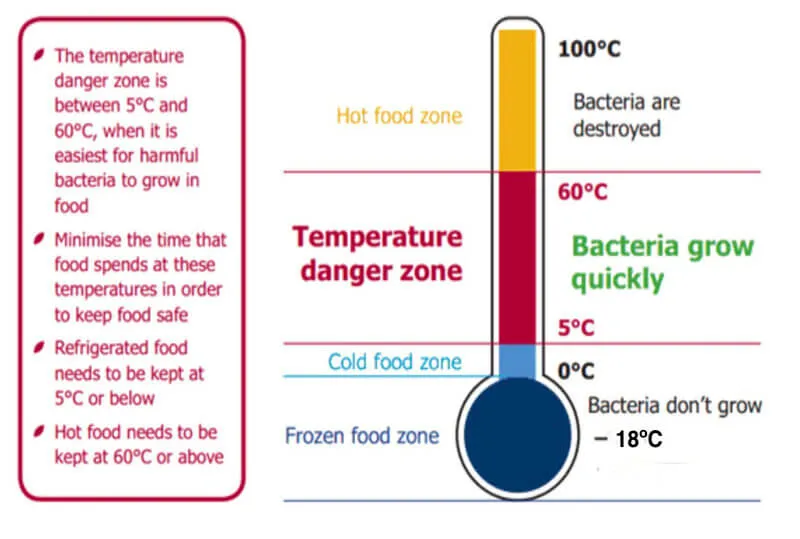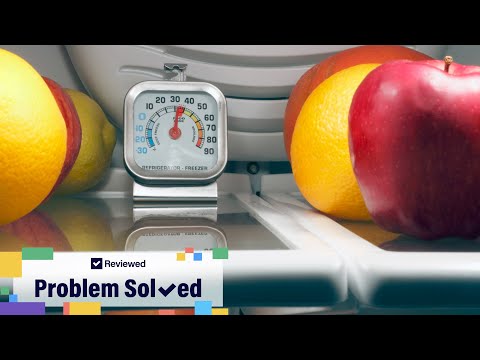Our refrigerators preserve our foods and beverages, but they can only do so under optimal temperature settings.
Refrigerator temperature at 50 degrees is a cause for serious concern. Common reasons include- blocked air vents, damaged condenser coils and fan, incorrect temperature settings, defective thermostat, dirty back unit, faulty compressor, etc. – the possibilities are endless.
There’s no way you can identify and troubleshoot possible causes all by yourself. You definitely need our help! So, keep scrolling below to explore what happens if fridge is at 50 degrees and what steps you can take to resolve it.
Table Of Contents

Why is My Refrigerator Temperature at 50 Degrees? Causes & Solutions
In order to figure out why is your fridge only 50 degrees, you need to access the back cooling unit of your fridge and examine the crucial components such as the condenser coils, evaporator fan, thermistor, air vents, temperature thermostat, control board etc.
Let’s begin diagnosing them one by one:
Make sure it’s set to the recommended temperature of around 37- 40 degrees Fahrenheit (2-4 degrees Celsius) for the refrigerator compartment. If there’s no improvement even after you’ve adjusted the temperature settings, perhaps the thermostat is defective and needs repairing.
Therefore, clean the coils regularly to ensure proper ventilation. Use bug sprays, insecticides or simply a vacuum cleaner for efficient cleaning.
You should also rearrange food items to allow proper air circulation. Keep food containers at least 2 inches away from the vents to ensure proper airflow. Never overload your fridge as it restricts warm air and moisture to go out.
Now, how will you understand if your vents are blocked? Stick your hand behind the refrigerator for a minute. Do you feel cool air blowing? If you feel little-to-no airflow, it’s likely that the vents are blocked.
A refrigerant leak can cause a drop in cooling efficiency. If you suspect this issue, it’s essential to call a professional technician to locate and repair the leak.
If you hear the refrigerator compressor making weird noises, running constantly or turning off and on more frequently than usual, you might need to replace it. But before replacing it, you could also try resetting your fridge compressor to see if it performs better.
1. Open the fridge door.
2. Take a dollar note and hold it in place where the door gasket and refrigerator meet.
3. Now, close the door.
4. Pull out the dollar without opening the door.
5. If you feel resistance when removing the dollar, that indicates the seal is still working. However, if the note slips out easily, you should perhaps replace the door gaskets.
Moreover, if your fridge was at 50° degrees due to some technical glitches or software-related issues, resetting will resolve those as well. Some refrigerator models feature a dedicated reset button. If yours doesn’t, simply unplug the appliance, wait for 10 minutes and then plug it back in.
Usually, manufacturers recommend at least 1 inch of clearance behind and above a unit, and ½ inch to each side.
You should adjust the front legs of your refrigerator with an Allen wrench or adjustable pliers. If the floor underneath is uneven, you may use wooden blocks or Styrofoam to adjust accordingly.
How Long Can a Fridge Be at 50 Degrees?
If your refrigerator temp has been at 50 degrees or more for a long time, you could be wondering how long can food be kept at 50 degrees. More importantly, is food safe at 50 degrees? Can you still eat that food?
Well, it really depends on what type of food it is and its expiry date. While some foods can tolerate temperatures slightly above the recommended range for short periods, it’s generally not advisable to keep your refrigerator at 50 degrees Fahrenheit for an extended time.
The U.S Food and Drug Administration (FDA) advises to throw away food that was left in room temperature for longer than 2 hours because bacteria grow between 50°F and 140°F, doubling in amount every 20 minutes.
When the temperature inside the fridge rises to 50° Fahrenheit (10°C) or above, it enters the temperature danger zone, potentially leading to food spoilage and foodborne illnesses such as salmonellosis and food poisoning.
While food safety guidelines can vary by region and specific food items, it’s generally recommended not to leave perishable foods at temperatures above 40°F for more than 2 hours.
Foods stored at 50°F may stay good for 24 hours if half-filled or even up to 48 hours if the food was completely frozen. The more cold the food was when you initially put it inside the fridge, the longer it will stay cold and fresh.
If your refrigerator has been consistently above 50°F for an extended period (several hours or more), check the condition of the food stored inside and throw away if necessary.

Here’s a list of perishable items that should be discarded immediately if they have been at this high temperature for an extended time, as they may no longer be safe to consume:
- Dairy products (milk, yogurt, cheese)
- Fresh fruits (berries, bananas, apples)
- Fresh vegetables (lettuce, spinach, tomatoes)
- Meat and poultry (chicken, beef, pork)
- Seafood (fish, shrimp, scallops)
- Eggs
- Deli meats and prepared salads
- Leftover cooked food
- Homemade sauces and dressings
- Fresh herbs
Likewise, certain food items may survive at temperatures around 50 degrees Fahrenheit (10 degrees Celsius) without immediate spoilage. Here’s a list of some less-perishable items:
- Canned goods (canned vegetables, fruits, soups)
- Dried pasta
- Rice
- Processed Bread (for a short period)
- Nuts and seeds
- Peanut butter
- Honey
- Vinegar
- Processed condiments (ketchup, mustard, hot sauce)
- Unripe fruits (avocados, bananas)
Keep in mind that while these items may not spoil quickly at 50 degrees Fahrenheit, they still have optimal storage conditions for taste, quality, and safety.
At What Temperature Does Food Spoil in The Freezer?
If you own a fridge-freezer and the refrigerator is operating at 50°F (10 degrees Celsius), it’s likely that the freezer section is also experiencing higher temperatures than it should. Most fridge-freezer units share a common cooling system, which means that the temperature in the freezer is influenced by the temperature in the refrigerator section.
The ideal temperature for the freezer section is between 0°C and – 1°C. When the temperature gradually starts to get higher than this, your frozen foods will start to thaw more quickly, the quality, texture, color and flavor of the foods will start to deteriorate.
Moreover, in extreme cases, when the freezer temperature reaches 4°C and keeps rising above, bacteria will grow rapidly and perishables such as – raw fish, seafood, poultry and meat will be spoiled. Eating such foods may cause foodborne illnesses and food poisoning.
How to Prevent Foodborne Illnesses in a 50 Degree Refrigerator?
If you want some exclusive tips and tricks on how to preserve your foods at such a high temperature for as long as possible and reduce spoiling chances, you’re at the right place. Follow these tips:
Frequently Asked Questions
Have got some more questions regarding your refrigerator temperature? Perhaps we have answered the queries hovering in your mind below. Feel free to take a look:
What is The Danger Zone in Fridge?
In the refrigerator, the Danger Zone typically falls between 40° Fahrenheit (4° Celsius) and 140° Fahrenheit (60° Celsius).
Can I Use a Thermometer to Check My Refrigerator’s Temperature?
Yes, using a refrigerator thermometer is an easy way to monitor the temperature inside your fridge and ensure it stays within the safe range.
How Often Should I Clean the Condenser Coils?
Aim to clean the condenser coils at least once every six months or more frequently if you have pets or notice significant dust buildup.
How to Test a Refrigerator Thermostat?
Take a glass of water and put a thermometer in it. Keep the glass in the middle rack of the fridge. Wait 5-6 hours before measuring to see what temperature the thermostat is set to.
Can You Check Fridge Temperature Without Thermometer?
Yes, you can. Put a glass or bottle of water in the fridge After 5 hours, take it out of the fridge and have a look at the container. Keep an eye out for condensation, as the faster it appears on the surface, the colder the temperature is.
Final Thoughts
We understand how frightening it is to see the refrigerator temperature at 50 degrees. But instead of panicking, you can be brave and take the matter into your own hands.
By following the steps outlined above, you can identify and resolve the issues, ensuring that your refrigerator functions optimally and your food stays fresh and safe to eat. If in doubt, you can always consult a professional technician for a thorough inspection and repair.
